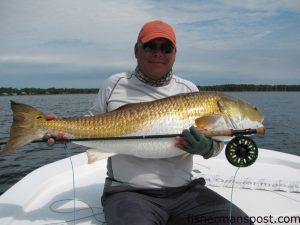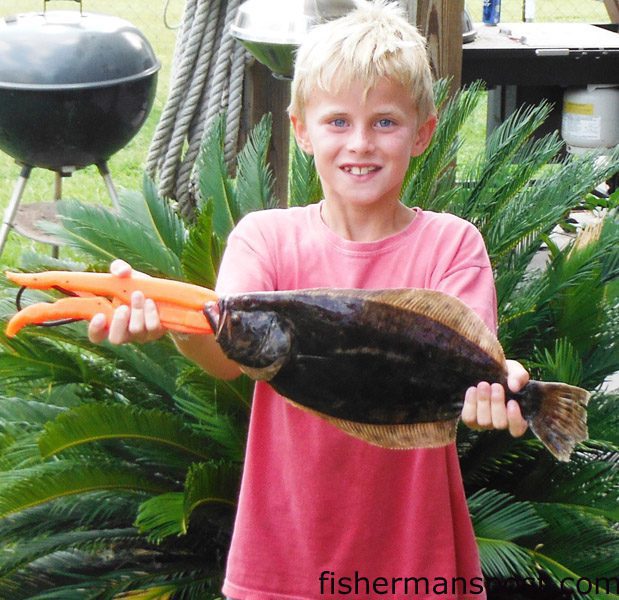Pamlico August 8, 2013

Rick Whorwood, of Ontario, Canada, with a 44″ red drum he caught and released in the lower Neuse River near Oriental while fishing with Capt. Gary Dubiel of Spec Fever Guide Service. The red struck one of Dubiel’s Lil’Hadden flies on an 11-weight outfit.
Gary, of Spec Fever Guide Service, reports that the citation-class red drum bite in the Pamlico Sound and lower Neuse River is turning on. Anglers are finding the big “old” drum on most trips and hooking them on relatively light-tackle while casting D.O.A. soft plastics under popping corks.
The drum are also feeding around drop-offs, shoals, and other bottom irregularities, where they’ll bite large cut baits fished on the bottom.
Puppy drum, speckled trout, and a few flounder are feeding along the river shorelines, especially in the lower river. Casting smaller D.O.A. soft baits under popping corks or on jigheads will tempt bites from the trio of inshore predators.
Striped bass are still on the feed around New Bern, and anglers can hook them on topwater plugs on the early morning and late evening hours. Stump fields and other shoreline structure are the best places to look for the stripers.
Some puppy drum are holding in the same areas and will pounce on topwater plugs, spinnerbaits, spoons, and other artificials.
Dave, of Knee Deep Custom Charters, reports that anglers are still connecting with good numbers of slot-sized puppy drum, speckled trout, and flounder (some keepers to 20”) in the lower Neuse River. Most of the action has been along the river shorelines, and live minnows have been producing the best results lately. Soft plastics are tempting bites from all three fish as well, and the trout and drum have also been biting topwater plugs when the water’s reasonably calm. Staying on the move until anglers find the fish is critical, as they’ve been spread out a bit.
There’s still a solid striped bass bite around New Bern. Anglers can tempt the fish to bite topwater plugs along the shorelines early and late in the day, and then switch to soft plastics around deeper structure when the sun’s high to stay on the bite.

Ryder Pressly (age 8), of Kinston, NC, with an 18″ flounder he hooked in the lower Neuse River while fishing with Capt. Dave Stewart of Knee Deep Custom Charters.
Large (40”+) “old” red drum have shown up around the mouth of the Neuse River, and anglers are hooking them while soaking large cut baits around drop-offs, oyster beds, and other bottom structure. They’re also hooking them by casting soft plastics on light tackle to fish they spot on or near the surface.
Mitch, of FishIBX.com, reports that anglers are still seeing some tarpon feeding in the Pamlico Sound, but it’s unlikely they’ll push up the rivers this summer due to all the rainfall. Some large red drum are also feeding in the sound and around the mouths of the rivers, and both the tarpon and drum will take an interest in large cut and dead baits fished on the bottom.
The big reds are also occasionally visible from the surface schooling and busting bait, and anglers can cast large artificial lures with success when they see signs of the fish.
Speckled trout, red drum, flounder, bluefish, croaker, and spadefish are all feeding around the shorelines and structure in the lower rivers and providing plenty of mixed-bag action.
Richard, of Tar-Pam Guide Service, reports that anglers are hooking solid numbers of slot-sized puppy drum in the lower Pamlico River. A few flounder and speckled trout are feeding in the same areas. All three are taking an interest in soft plastic baits below popping corks and on jigheads. Live baits like mud minnows on the same rigs are also effective.
Isaiah, of East Side Bait and Tackle, reports that anglers are seeing a decent, but not great, tarpon and large red drum bite around the mouth of the Pamlico River and into the sound. Large cut baits are fooling both fish.
Speckled trout and flounder are feeding in the Pamlico and Pungo rivers, with the best action (and largest fish) still the furthest to the east. Anglers are hooking both fish all the way up to Bath as well, but it’s been a bit better down towards the sound. Some puppy drum are mixed in with the specks and flatfish, and all are falling for Gulp baits.
Striped bass are feeding around structure near Washington and Chocowinity. Anglers are fooling them with topwater plugs early and late in the day, and then with Rat-L-Traps, bucktails, and other subsurface lures when the sun’s high.





